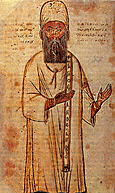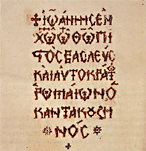 |
|
 |
Historiographical works of the 13th and 14th century
 he momentous
events
which took place in the Byzantine empire from the time of the first conquest of Constantinople by the Franks in 1204 he momentous
events
which took place in the Byzantine empire from the time of the first conquest of Constantinople by the Franks in 1204
 to the middle of the14th century were recorded by four eminent personalities in their Histories, each writer continuing, consciously or not, the work of the other. All of them (three scholars and one emperor) lived close to the imperial court of Constantinople and were therefore in a position to follow developments at first hand. to the middle of the14th century were recorded by four eminent personalities in their Histories, each writer continuing, consciously or not, the work of the other. All of them (three scholars and one emperor) lived close to the imperial court of Constantinople and were therefore in a position to follow developments at first hand.
George Akropolites was the first in this list of historians. He recorded events from 1203 to 1261 in his work Chronike Syngraphe, thus continuing the work of an older historian,
Niketas Choniates. His position as
commander-in-chief of the army and diplomat gave him the opportunity to be in the middle of the action. He therefore described the rise of the Empire of Nicaea and the re-establishment of the Byzantine Empire in Constantinople in 1261. He considered the latter to have been achieved by Divine Providence, of which the emperors of Nicaea and Michael Palaiologos were the instruments.
His disciple and successor,
George Pachymeres, did not see eye to eye with him. In the 13 books of his work Syngraphikai Historiai he recorded, in a more pessimistic mood, the events of the period between 1260 and 1308. The reason for this was the situation in the empire, which he perceived not from the viewpoint of a politician or a general but in his capacity as a functionary of the Patri
archate of Constantinople. The
Turkish tribes were extending their sway over the Byzantine territories and Byzantium had to wage a battle on two fronts: both against them and against the Latins.
 The most eventful century, the 14th century, which was marked by the civil wars of the time of
John VI Kantakouzenos, was
described by the two other historians of the period: Nikephoros Gregoras and John Kantakouzenos himself. What is very interesting is that each describes the same facts from a different point of view. Nikephoros Gregoras, a student of Theodore Metochites and head of a "University" at the time, of the School of Chora, that is, describes in detail events before 1328 and until 1359 from the viewpoint of an anti-hesychast. His work, Rhomaike Historia, in 37 volumes, also recounts the history of the entire period from 1204 to 1359 and contains important information that we do not find in Akropolites or Pachymeres. The most eventful century, the 14th century, which was marked by the civil wars of the time of
John VI Kantakouzenos, was
described by the two other historians of the period: Nikephoros Gregoras and John Kantakouzenos himself. What is very interesting is that each describes the same facts from a different point of view. Nikephoros Gregoras, a student of Theodore Metochites and head of a "University" at the time, of the School of Chora, that is, describes in detail events before 1328 and until 1359 from the viewpoint of an anti-hesychast. His work, Rhomaike Historia, in 37 volumes, also recounts the history of the entire period from 1204 to 1359 and contains important information that we do not find in Akropolites or Pachymeres.
John Kantakouzenos, who reigned
as emperor from 1347 to 1354 was, on the contrary, a supporter of hesychasm and was responsible for the civil war. In spite of the fact that he made an effort to be objective, his Historiai inevitably ended up being an apologia, an attempt to justify his political actions. Kantakouzenos was the last important historian of the 14th century. In the second half of the century, no more histories were written, so that our only source of historical information thenceforth are the chronicles.
See also: George Akropolites,
George Pachymeres,
Nikephoros Gregoras,
Theodore Metochites,
Hesychasm,
Chronographies
|